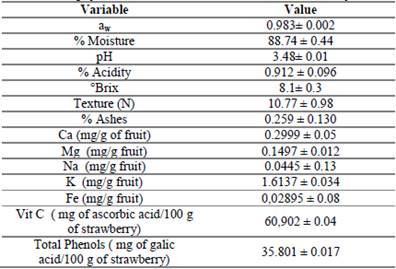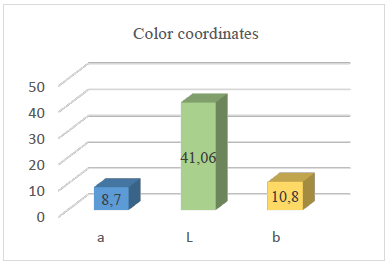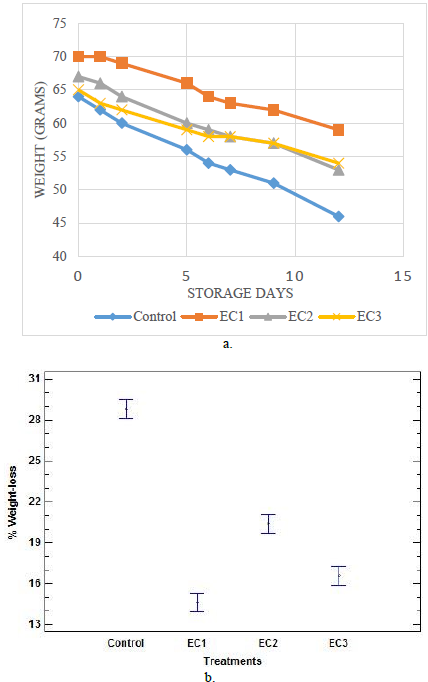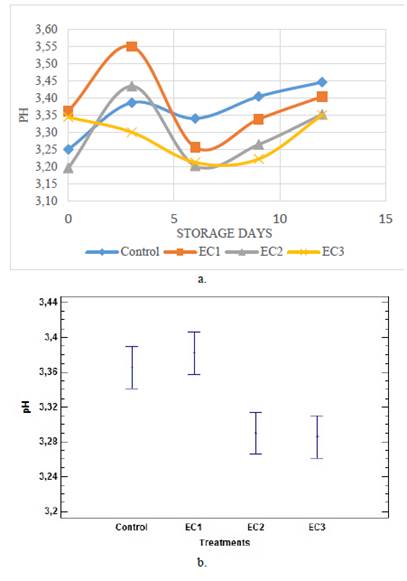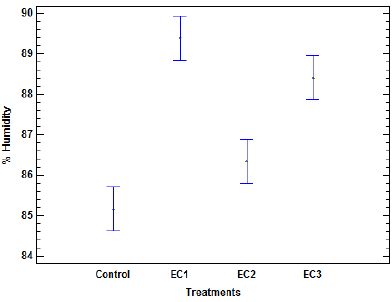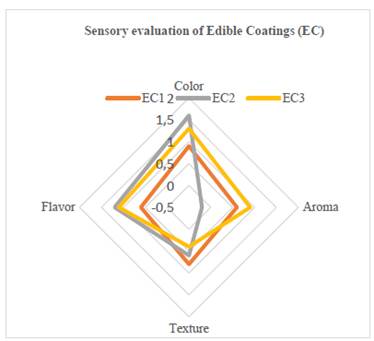1. Introduction
Strawberry (Fragaria x ananassa) is a pulpy fruit, very desirable for fresh consumption due to its excellent nutrition characteristics, high levels of flavonoids - reported as natural antioxidants, characteristic acidity - and high water content. This fruit, given the absence of peel and its high water activity, is very prone to microbial attack, especially by the Botrytis cinerea fungus, which makes it highly perishable, making its shelf life time very short and increasing post-harvest losses. Another disadvantage of strawberry in not having a shell is that the pulp is exposed to the environment, helping the degradation of its nutritional components, especially flavonoids because of the reactions that can take place through contact with ambient oxygen, in addition to the mass transfer that occurs due to the fruit’s dehydration, which causes loss of turgor and, therefore, a decrease in its quality characteristics [1]. Increased consumer interest in healthy, nutritious, natural products has guided and motivated research towards developing conservation techniques applied to horticultural products as a means of reducing the rate of deterioration in the quality attributes of fruits during storage.
Due to this, food science and technology has been working arduously to manage strategies that allow reducing post-harvest losses of these types of fruits, protecting them from external environmental factors, microorganisms, and improving their rheological characteristics that allow optimizing packaging and transport processes [2]. One of these new strategies is the, so-called, minimally processed food technology, which, as the name implies, is an operation that helps to preserve especially fruits and vegetables with minimal procedures, without heat treatments and, in some cases, with the application of chemical components that help to reduce their microbial load and improve their texture [3, 4]. These operations help to extend the shelf life of fruits, preserve their organoleptic characteristics (flavor, aroma, texture, and color), preserve their turgor by using a protective barrier that can be generated, and protect the product from fungi, yeast, and bacteria attacks [5].
Several operations have been reported to process fruits and vegetables minimally, such as edible coatings (EC), chemical baths, ultraviolet treatments, ultrasound, pulses, and low-pressure, among others. [6]. Edible coatings have been among the main operations used for this purpose due to their low cost, versatility in the mode of action, and excellent results obtained in conservation of fruits by increasing their shelf life [7].
An EC can be defined as a thin layer deposited on the fruit surface to protect it from external factors and the exchange of mass with the medium. These coatings are usually polymeric compounds, especially carbohydrates, such as native and modified starch, xanthan gum, guar, arabic, chitin, and chitosan among others and proteins, such as caseinates, applied by seeding the fruit in a colloidal suspension formed by the coating [1].
Several authors have reported on the protection of berries with EC. Genskowsky et al., 2015 [8] evaluated edible chitosan films on Chilean mulberry extracts (maqui berry) to inhibit the growth of some bacteria and preserve the antioxidant capacity of the extracts. The study showed that the coated extracts preserved their antioxidant capacity by 80% and determined inhibition in the growth of the mesophilic microorganisms present in the environment. Guiyun Yang et al., 2014 [9] evaluated the effect of coating with chitosan incorporated in different concentrations on fresh strawberries. It was demonstrated that chitosan coatings helped to preserve the initial concentrations of phenolic compounds and, thus, ensure that physiologically active compounds remain inside the fruit during storage. Correa-Betanzo et al., 2011 [10] evaluated the treatment with sodium caseinate plasticized with glycerol on cactus berry as an edible film. Polyphenol content was evaluated, finding concentrations of 3500 mg/100 g of dried fruit. These levels decreased by 50% during seven days of storage. On the contrary, betalaine levels remained constant during seven days of storage. Antioxidant capacity was also measured and constant activities were reported during seven days of storage.
Wang et al., 2011 [1] studied the effect of edible films based on chitosan as coating on strawberries, evaluating antioxidant capacity, enzymatic antioxidant system, and the quality of the fruit in postharvest. It was determined that the shelf life of the product increased when the fruits were treated by immersion in chitosan solutions of 0.5, 1.0, and 1.5 g/100 mL for 5 min at 20 °C, compared to the control treatment. These treatments also helped to maintain phenol, anthocyanin, and flavonoid concentrations.
Given the background, the objective of this project was to obtain strawberry products minimally processed by edible coatings to prolong the shelf life of strawberry, maintaining the physicochemical, sensory, and microbiological properties during its conservation.
2. Materials and methods
2.1. Preparation of the sample
Freshly harvested strawberries (Fragaria x ananassa), grown in the municipality of Pijao (Quindío, Colombia) were used. These were classified by taking into account uniformity in their degree of maturity, shape, and size; thereafter, they were transported to the DNP laboratory at Universidad del Quindío, washed with water, and disinfected with 500 ppm of sodium hypochlorite solution and stored under refrigeration conditions ± 10 °C for 15 days.
2.2. Physicochemical characterization of the raw material
Physicochemical characterization of fresh strawberry. The following physical and chemical parameters were evaluated in fresh strawberries and after each treatment: water activity (aw) was determined following the methodology proposed in AOAC 2.1995. Humidity was determined according to the AOAC 20.013 method; acidity percentage was evaluated according to the NTC 4623 norm (1999); total soluble solids were determined following the AOAC 932.12 method; hydrogen potential was calculated ny using the AOAC 981.12 method; ashes were quantified by using the AOAC 7009/84, 942 method, adapted 05/90; contents of Ca, Na, Mg, Fe, and K were determined according to the NTC 5151 by ICONTEC, using the Thermo Electron flame spectrophotometer Corporation S4AA Spectrometer (NTC, 2003); vitamin C was determined by following the colorimeter method of 2-nitroaniline, proposed by the Department of Chemistry at Universidad Nacional de Colombia, in a UV-vis spectrophotometer, read at 540 nm. The results were expressed as ascorbic acid mg/100 g sample. The total phenolic content was determined by the Folin-Ciocalteu method [12]. Absorbance was measured 30 min after the start of the reaction on a Hewlett Packard Chemstation 8453 G1115AA UV-vis spectrophotometer and gallic acid (GA) as a standard for the calibration curve, read at 765 nm. The results were expressed as mg AG/100 g sample. Color was determined in a MINOLTA CR-10 colorimeter by measuring the CIE Lab L, a, and b coordinates, with D65 illuminant and with a standard 10° observer and the ΔE parameter was calculated to determine the color change in the treatments and texture was determined the maximum puncture and penetration load with the respective deformation of the strawberrys with a STABLE MIC texturometer, model TAXTPLUS, using the Texture Exponent 32 Version 2.0.6.0 software.
2.3. Application of edible coatings (EC)
Three coatings were evaluated: chitosan solution (1%, 2%, and 3%), calcium caseinate solution (1%, 2%, and 3%), and low methoxyl pectin solution (1%, 2%, and 3%) with glycerol as a 1.5% plasticizer. The treatment for each of each coating was carried out at 70 °C with continuous agitation at 700 rpm for 2 min by immersing the strawberries in the solutions; strawberries submerged in distilled water were used as a control treatment. Subsequently, the coated strawberries were dried for 1 h at room temperature, packed in polypropylene containers, with perforations (four fruits/container) and stored at ±5 °C and 95% relative humidity (RH) for 15 days. The response variables were the physicochemical parameters described in 2.2 and shelf life, measured on days 0, 3, 6, 9 and 12.
2.4. Physicochemical characterization of the treatment
The same physicochemical parameters described in section 2.2 were evaluated on strawberries treated with EC, taking as reference the control parameter during the storage time. In addition, the loss of weight by gravimetry was determined by the difference between weights. The initial weight (Wi) minus the fruit weight at the end (Wf) of the storage was taken and the results were expressed as percentage of weight loss (% WL) by Eq. (1) [15]:
2.5. Storage deterioration evaluation
The deterioration time was determined with real-time studies; this type of study consists of keeping the strawberries underthe conditions foreseen for storage at 5 °C and 95% RH. The quality parameters described in 2.2 were evaluated during 15 days of storage to determine the time it takes to lose the physicochemical and sensory properties against fresh fruit.
2.6. Microbiologic analysis
The microbiological analysis was performed in fresh strawberries and with conservation treatments, evaluating the following parameters: aerobic mesophilic count and total coliforms, mold and yeast count according to ISO 7954 (1987).
2.7. Sensory evaluation
The sensory analysis was performed with scalar descriptive tests quantifying the sensory differences by 12 semi-trained judges who determined the sensory properties of the samples (color, aroma, texture, and taste). The evaluation was carried out using a score scale of -2, -1, 0, 1, and 2 that corresponds to the different degree values set for the degree of intensity of the attribute assessed, compared to the fresh fruit where zero is the pattern, (-2) the characteristic furthest from the pattern and (+2) the feature most similar to the pattern or most pleasing. The data were processed with Tukey's comparative statistical technique with 95% confidence level.
The significance study of the different effects and their possible interactions was carried out by using simple analysis of variance (ANOVA) using the Tukey HSD (honestly significant differences) method as a multiple-comparison technique, with a level of significance (α) of 0,05 in the Statgraphics Centurion XVI.II statistical package.
3. Results and discussion
3.1. Physical-chemical characterization of fresh strawberry
Table 1 shows the physicochemical characterization, the mineral content, vitamin C content (mg of ascorbic acid/100 g of strawberry), and total phenols (mg of gallic acid/100 g of strawberry) in fresh strawberry.
Strawberries are perishable fruits, with a high respiration rate and susceptible to mechanical damage during post-harvest; they have aw of 0.983, making them vulnerable to microbiological damage, given that aw is defined as the ratio of water available for chemical and microbiological reactions to the total humidity of the product and, therefore, plays an important role in the enzymatic activity of food, influencing physical properties, like texture and shelf life. It is a parameter closely linked to the food’s humidity (88.74%), which allows determining its capacity for conservation, microbial proliferation, etc. Water activity, temperature, acid pH (3.48), and oxygen are the factors that most influence the stability of food products; strawberry has an acidic pH, low acidity, and a relatively low soluble solids content. Similar behaviors were previously reported [13] with pH values of 3.51; 0.87% acidity, and 7.8 in the SST of the strawberry. As seen in Table 1, strawberries are a rich source of minerals, such as potassium (1.6137 mg/g of strawberry), calcium (0.2999 mg/g of strawberry), and magnesium (0.1497 mg/g strawberry). Similar values have been reported in mora Castilla (Rubus glaucus) [14]. The strawberry is a rich source of antioxidants; among the most remarkable properties of this fruit is its abundance of vitamin C (60.902 mg of ascorbic acid/100 g of strawberry) and total polyphenols (35.801 mg of galic acid/100 g of strawberry). Free radicals are molecules that generate a destructive process in the cells of the organism, before it the human body defends itself by means of a control system that creates the so-called antioxidants, nutrients of vital importance because it has an action that blocks the "free radicals". Other researchers [14] have found that strawberry has a high content of antioxidant compounds.
Fig. 1 shows that strawberry has positive values of a* at 8.7, indicating a hue close to red and b* at 10.8 inclined to a yellow hue. These values agree with their reddish hue, besides being an indicator of their maturation. These reddish colors are observed due to the presence of vegetable pigments (flavonoids), known as anthocyanins, responsible for antioxidant properties. The L* parameter indicates the brightness, this value is associated with the brightness present in the epidermis of the fruits.
3.2. Application of edible coatings
The concentrations of the coatings were selected from preliminary tests in which these proved not to affect the physical or sensory appearance of the fruits. Table 2 shows the suitable formulations for the different edible coatings.
Table 2 shows the formulations of EC applied to strawberries via immersion method. The polysaccharides (chitosan and low methoxyl pectin) and the protein (calcium caseinate) used in the mixtures are polymers that form cohesive molecular networks through high interaction among their molecules. These polymers provide good mechanical and gas barrier properties (O2 and CO2), which slows the respiration and aging of fruits. The additives (citric acid and ascorbic acid) are substances used in formulations to maintain texture, are antimicrobial, antioxidants, nutrients, and bioactive ingredients capable of increasing the nutritional and functional value of vegetable foods, and glycerol is a plasticizer used in each matrix to improve the flexibility and adhesion of coatings on fruits. Fig. 3 shows the different formulations of the EC and the coated fruits.
3.3. Characterization of strawberries with coating
The strawberries with EC were stored for 15 days, performing physicochemical analyses every three days to determine their shelf life. It was found that EC1 had a 14-day shelf life, EC2 had 12 days, EC3 had 13 days, and the control had 7 days. Therefore, physicochemical analyses were performed until day 12 of storage. Fig. 3 shows the weight-loss kinetics of the EC during the days of storage and by treatment.
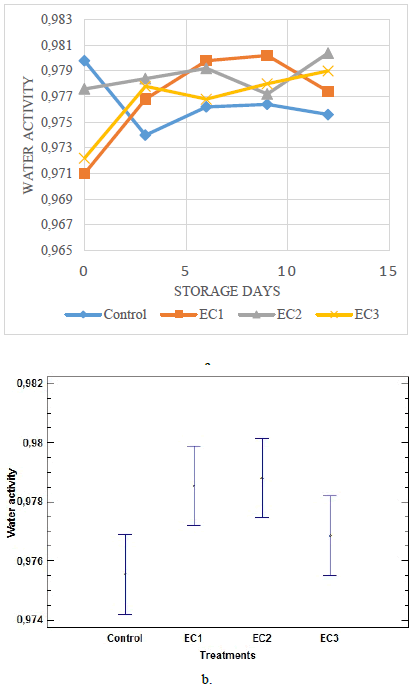
Source: The autors
Figure 3 a) Water activity kinetics of EC during storage. b) Water activity behavior of EC
Fruit weight loss increased with storage time in all treatments as a result of perspiration. However, the fruits treated with the edible coatings significantly reduced the weight loss with respect to the control (P <0.05) (Fig. 2-b). The RC1 was the most effective treatment in reducing the loss (14.51%), because the application of these coatings creates a semipermeable barrier to gases and water vapor similar to a modified atmosphere, which reduces the breathing speed and the dehydration of the coated products. Similar behaviors were reported beforehand for strawberry [15] and Japanese medlar [16], where the weight loss of the fruits was significantly reduced with the use of chitosan as a coating.
The physicochemical analysis was carried out on edible coatings and on control during days 0, 3, 6, 9 and 12 of storage; evaluating parameters such as water activity, soluble solids, pH, percentage of acidity, color, humidity percentage, total ash, mineral content, texture, ascorbic acid and total phenols to determine the loss of physicochemical properties of each treatment during storage.
The fruits with edible coatings increase the free water content during storage, while in the control fruits it decreases, presenting a statistically significant difference with respect to the treatments RC1 and RC2 (P <0.05) (Fig. 3-b); This is because the coatings create a barrier that reduces transpiration, since the water activity is a parameter closely linked to the humidity of the food; while control fruits show accelerated dehydration during storage. Similar behaviors have been previously reported [17] with the use of chitosan in mango minimally, where a decrease in the amount of free water was observed in the control samples with respect to the treatments.
Soluble solids increased in strawberries with EC during storage (Fig. 4-a), showing a significant difference (p <0.05) with respect to the control by increasing the value of this parameter. This behavior is related to the increased acidity percentage (Fig. 4-a), where the control presents a higher percentage with respect to the treatments, which translates into a higher content of organic acids that are used in the respiration; consequently, the sugars present in the fruits diminish. Other researchers [18] reported similar results in minimally processed pineapple-coated foods with cactus mucilage (Opuntia elatior Mill.), finding that the TSS content of the fruits with EC showed significantly higher values than the control, and concluding that EC creates a modified atmosphere that slows down the metabolic reactions related to the respiration of fruits.
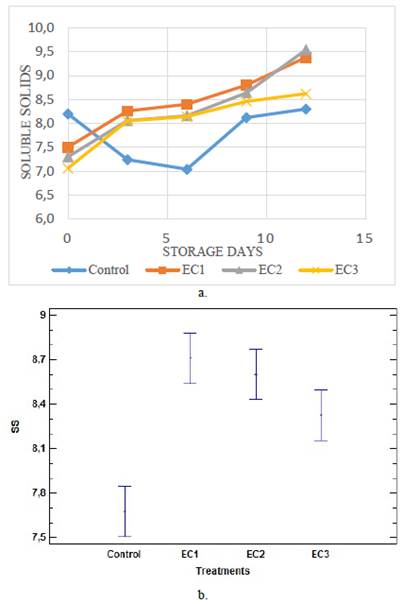
Source: The autors
Figure 4 a) Kinetics of soluble solids in EC during storage days. b) Behavior of soluble solids of EC through statistical analysis with statgraphics.
The pH value of EC2 and EC3 during storage is lower, presenting a statistically significant difference (p <0.05) with respect to the control and to EC1 (Fig. 5-b). This is possibly due to the addition of ascorbic acid to the coatings with a lower value of this parameter. In food stability, it is most appropriate that the product during storage present low and constant pH values, since this condition does not allow the proliferation of microorganisms. Similar behaviors have been reported previously [1], where the pH of strawberries coated with mucilaginous gel of aloe vera leaf (Aloe barbadensis Miller) and carnauba wax was reduced.
Application of coatings significantly reduced (p <0.05) the acidity percentage of the fruits during storage with respect to the control samples (Fig. 6-b), this is because possibly in the case of edible coatings, these slow down the respiratory frequency of strawberries and delay the use of organic acids in enzymatic reactions. The results obtained on acidity coincide with those from different studies on the application of edible coatings based on chitosan, gelatin, and wheat gluten in strawberries in refrigeration storage. In 2013 [15], it was found that the acidity of the strawberries coated with dextran and pectin was lower compared to the control samples.
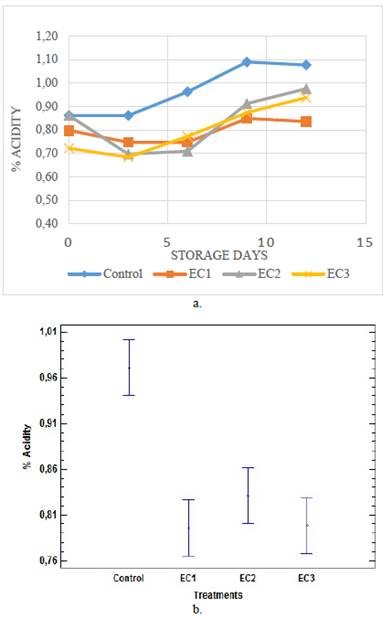
Source: The autors
Figure 6 a) Kinetic of the acidity percentage of the EC during the days of storage. b) Behavior of the acidity percentage of EC through statistical analysis with Statgraphics.
Table 3 shows a significant color change during storage in the control samples (ΔΕ> 5) with respect to the treatments, because the EC act as selective barrier that prevents the fruit’s exposure to ambient oxygen, inhibiting possible oxidation reactions, while in the control fruits darkening of the skin (greater ΔE *) increased progressively, probably due to the degradation of the ascorbic acid by its degradation over time, which favors the browning enzymatic reactions. Coated strawberries do not present significant color change during storage; however, that with the highest ΔE * is the EC2, this possibly occurs because this coating with calcium caseinate has a slightly milky appearance due to the presence of micelles of casein intact. Previously, penila aloe mucilaginous gel in strawberries was evaluated as an edible coating, finding significant color differences (ΔΕ> 5) of the control with respect to treatment [1].
Table 3 Color change (ΔE) of the EC with respect to the control during storage days

Source: The autors
Fig. 7-b shows a significant difference (p <0.05) in the texture behavior of the control against all coatings; it is evident that EC1 was the most effective in reducing the loss of firmness, conserving this property and quality attribute during storage. The behavior observed is related with the formation of a surface barrier in the fruit generated by the coatings, modifying the internal gaseous composition, which decreases the respiration rate and the degradation of the cell wall compounds, maintaining the initial characteristics measured. The loss of water experienced by the fruits during storage is accompanied by softening and wrinkling, as a consequence of the enzymatic activity during maturation and senescence of the tissues. In another investigation it was found that the application of the coatings in chitosan and sucroster significantly improved the firmness of Japanese medlar fruits with respect to the control samples [16].
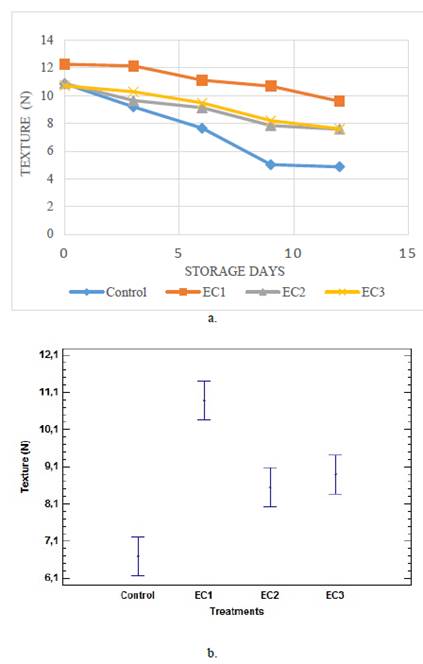
Source: The autors
Figure 7 a) Texture kinetics of EC during days of storage. b) Texture behavior of EC through statistical analysis with Statgraphics.
Significant difference is observed in Fig. 8 in all the treatments (p <0.05), with the control having the lowest humidity percentage, which could be explained by the barrier action of the coatings on the fruits avoiding dehydration during storage. Water is the most abundant component in fruits, with levels between 89% and 94%. Fruits are highly sensitive to dehydration, making it recommendable to carry out post-harvest storage of the strawberry at 90% - 95% relative humidity. The EC1 was the most effective in avoiding a greater proportion of water loss during storage. Similar behaviors have been reported [15], where edible coatings of pectin, dextran, and chitosan applied to strawberry, cranberry, and feijoa showed statistically significant effects (p <0.05) on the reduction of water loss during storage.
In Fig. 9, a statistically significant difference in vitamin C content is observed among the treatments with respect to the control (Fig. 9-b); this is due to the composition of each coating because some treatments have added acid ascorbic in their matrix as a coating material, which increases its final antioxidant content. Fig. 9-a shows a significant difference (p <0.05) of EC1 compared to all treatments in terms of total phenols. This increase in antioxidant compounds in the control,
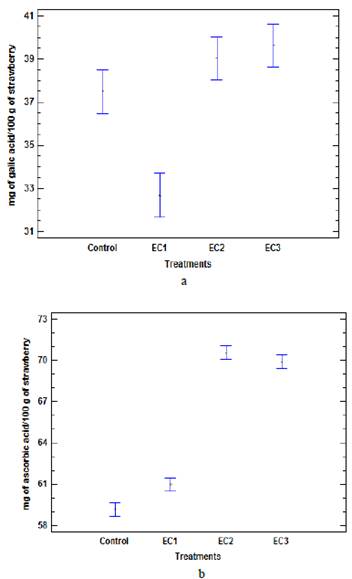
Source: The autors
Figure 9 a) Content of total phenols in EC (mg of galic acid/100 g of strawberry); b) vitamin C content in EC (mg of ascorbic acid/100 g of strawberry).
EC2 and EC3 can be attributed to a higher enzymatic activity in the biosynthesis of phenolic compounds, as reported [19], in this study on mora de Castilla, while the lowest value of total phenols was found in strawberries treated with chitosan (EC1) and this is probably because it was the treatment with the least deterioration (greater acceptability) and perhaps this is related to the effect of EC in decreasing the activity of enzyme phenylalanine ammonia lyase (PAL) and/or delaying the deterioration process and, thereby, decreasing the accumulation of said phenolic compounds due to decreased metabolic processes of the product that bring with along its senescence. Similar behaviors have been reported, which found that the effect of chitosan coating on strawberries could maintain total phenol content [13].
In relation to the microbiological analysis and according to NTC 6005, which establishes the microbiological requirements for minimally processed foods, the EC comply with the standard that establishes a good quality level, with values for mesophiles <100,000 CFU/g and for E. coli <100 CFU/g. In general, the treatments decreased microbial growth with respect to the control samples; EC1 was the most effective coating because it totally inhibited this microbiological growth, meaning a prolongation of the shelf life of fruits during storage. This behavior is attributed to the antimicrobial and antifungal properties of chitosan; these aspects make it of vital interest for the preservation of food and emerging technologies.
Fig. 10 shows the results of the sensory analysis performed on strawberries with EC. The radial scales on positive scales indicate greater acceptability of the strawberries with coatings against the control, while the attributes on negative scale establish differences compared to fresh strawberries. As evidenced by the aroma of EC2, it has lower acceptability, which is because the EC behaves as a semipermeable barrier that reduces the passage of aromatic compounds released by the fruit. All the coatings used had good acceptance in all aspects evaluated, EC2 and EC3 stand out in attributes, like taste and color; however, EC1 was the treatment with the most symmetry of evaluation in the scale of attributes, being the closest to the control samples (scale 0), this indicates that this coating (chitosan) retains the properties of the strawberry in its fresh state, which is essential for consumer acceptability.
4. Conclusion
The edible coatings used were effective in strawberry conservation, showing statistically significant effects (p <0.05) in reducing weight loss directly related to the loss of water. The coatings create a protective film on the skin of the fruit, allowing to decrease the loss of water vapor during respiration and transpiration processes, maintaining fruit quality for longer periods. Edible coatings allow to obtain greater resistance to penetration, diminishing the loss of fruit quality due to mechanical damage. The EC1, based on chitosan, applied on fresh strawberries was the best treatment, prolonging the shelf life up to 14 days, inhibiting the microbial growth in the fruits, decreasing moisture loss, respiration index, and maintaining firmness and sensory properties of the strawberry in fresh condition.














